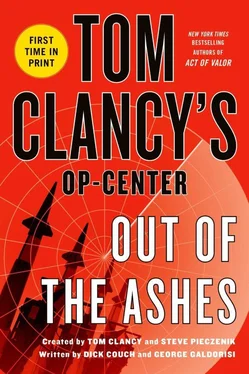“So, command pilot. My wives no longer interest me and I haven’t been with a woman for far too long. You say your friend is your responsibility. Let’s see if you really mean that.” Turning toward Makhdoom, he continued. “Once you have the board, bindings, and blankets down on the floor, strip that other one and tie her down. Then leave the three of us alone. This … this … command pilot is the only one who will watch me satisfy myself.”
* * *
Master Guns Moore looked through his Fujinon 16x40 S1640 stabilized binoculars as the JSOC team crouched on a large sand dune about a half mile from the blockhouse. They were on a slight rise with good visibility of the site.
“That’s definitely a U.S. Navy helicopter, sir,” Moore began. “Can’t make out the tail numbers yet, but it’s a Navy Seahawk. I don’t know how anyone survived that crash. Guess we’ll find out once we get down there. That other helo is most certainly an executive bird.”
“See any other activity?” Volner asked.
“No, sir, just the crashed helo, the executive helo, and the blockhouse. The executive bird must have brought someone here and they’re probably inside.”
“Can you see if there’s a pilot in the executive bird?”
“Not from this angle, sir.”
“All right.” Volner keyed his 152 intersquad radio. “OK, fellas. We’ll angle around to the right and come up from behind the helicopter, and set up a sniper overwatch when we’re about four hundred meters out. If there is someone in that bird, we’ll detain him. If he sees us or makes a move — kill him. Then we move on the blockhouse. We need to bring our two Americans out alive, so hostage protocols are in effect.” He was answered by a series of squelch breaks. “Let’s get it done.”
* * *
Standing on the wide bridge of USS Ponce, Commodore Joe Armao was focused on his mission: preparing to clear the mines U.S. intelligence had told them the Iranians were about to sow near the approaches of the Strait of Hormuz. Armao was a twenty-four-year Navy veteran and had been training for this his entire professional career. Now, as the Navy’s forward-deployed Mine-Countermeasures Squadron commander, Armao was ready to do his job. Ponce was a ship that was almost as old as he was. She was decommissioned, laid up, and later brought back into naval service to be the Navy’s only Afloat Forward Staging Base. She was his flagship and he loved her. Since July 2012, Ponce had been moored pier side in Manama, Bahrain. She put to sea only occasionally, waiting for missions worth the significant cost and effort of bringing her back to life. The Navy no longer officially referred to ships as “she,” but Armao was of a time when they did, and he was not about to change now.
Now she had that mission, and Armao was the mission commander — the squadron commodore. Three enormous MH-53E Sea Dragon helicopters sat on Ponce ’s flight deck. Behind the flagship steamed six small mine-countermeasure ships. Armao called them his ducklings. The skyline of Manama receded in the distance as the little flotilla made best speed toward the Strait of Hormuz. Speed was of the essence. Mines laid in the water near the Strait of Hormuz would completely stop shipping in and out of the Gulf.
* * *
The first MH-60M Pave Hawk slipped back from the C-130H Combat Talon II, its belly full of fuel, as the second helo pushed closer, its long fueling probe inching closer and closer to the Combat Talon II’s towed refueling basket cone. A combination of the downdraft from the Combat Talon’s four engines, the updrafts from the desert floor three thousand feet below, and the helo’s rotor wash made for a bumpy ride. It was a complex but well-practiced piece of airmanship. Once refueled, the helos and the C-130H would continue to orbit north of the Saudi Arabian border, waiting for the go order and for Op-Center’s Geek Tank to take down the Saudi air traffic control system. Then the two helos would begin their eighty-five-mile dash to where Volner and his team were working to extract the two American hostages. Meanwhile, the special operations Pave Hawks and the Talons would maintain an on-call orbit.
Eastern Saudi Arabia
(March 22, 1900 Arabia Standard Time)
Mike Volner’s team had made their way to the blockhouse without incident and on the way had surprised the prince’s pilot. They bound him with nylon cuffs, gagged him, and stashed him out of sight in the back of the executive helicopter. To the west, the sun was just setting over the Saudi Arabian desert. One element of the team had arrayed themselves along a shallow dune line to serve as a security element and blocking force. Two snipers had the area under their muzzles. Volner and the assault element were now pressed against the outside wall of the blockhouse. The lead assaulter carefully put a small linear breaching charge on the door while a teammate held on the door with his M-4 rifle. The third man in the stack, also camped over his M-4, had two flash-bang grenades at the ready. Volner nodded to the breacher as the line of assaulters flattened up against the wall.
“Fire in the hole,” he said in a low, conversational voice and pulled the plunger on the Nonel firing system.
WHAM! The door handle was cleanly defeated and the door hung by a single hinge. Then the number two man kicked the door aside and went in. The rest of the assault team, save for Volner, poured through the door like a ballet troop rushing on stage. Volner, as the ground-force commander, would remain in a control position outside while his team lead would run the fight inside — but there was no fight. The assault element quickly took charge of those inside without firing a shot.
The prince, the chief engineer, and his half dozen men were quickly overwhelmed by Volner’s squad. It was over in forty seconds. What the Saudis could not know was the two Americans they held may have saved their lives. Without them, the JSOC team would shot anyone who was armed or even near a gun.
“Clear!” The lead assaulter called out from the rear of the blockhouse.
“Clear!” Moore repeated. “Building secure.”
“Building secure,” Volner echoed over the 152 net. “Security element, collapse in and hold on the target area.” After the security element leader rogered up, Volner moved to the door of the blockhouse. “Coming in,” he called to his team inside.
“Coming in,” Moore yelled back. Only then did Volner enter the building.
The Saudis, including the prince, who was half dressed, were all seated against a wall, their hands bound behind them with snap cuffs. All had bags over their heads. One of the assaulters was carefully helping Laurie back into her flight suit. The team medic was tending to Sandee. The sensitive site search team was about their tasks, collecting computer hard drives and documents, and photographing everything.
“Team lead,” Volner called.
“Right here, sir.”
“Get these guys into that back room. Then bring the fat, half-dressed one outside and put him on his knees.”
“Roger that, sir.”
With a gun to his head, the prince’s helo pilot identified the man kneeling by the blockhouse as Prince Ali al-Wandi, the deputy minister for energy for the Kingdom of Saudi Arabia. Volner stepped over to his communicator, who had a satellite antenna rigged to his PRC-147 radio and a secure channel with Op-Center.
“Major Volner, here.”
“Major, Brian Dawson. You hear me all right?”
“Five by five, Colonel,” Volner replied, referring to Dawson’s military rank.
“OK, Mike, give me a status.”
Читать дальше












